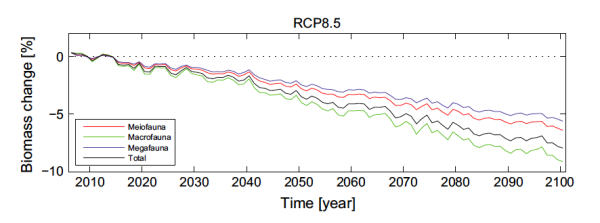
Few things give me greater joy than a model. No not those waifs that strut the fashion runways but mathematical models. Sure my pulse increases with the mention of deep sea, body size, food (in the scientific sense), snails, or combination thereof. Stop you had me at gigantism. But model with projection plots, equations, and altered assumptions…o’ baby. But a model that combines food, deep sea, body size…mercy.
Earlier this year, Daniel Jones and colleagues published a model that has done just this. I’ve been one wanting to write about this for a while but wanted the model to age a bit and the come back to it like a fine wine. The premise of model is simple. What happens to the total amount of deep-sea life under climate change? If you took all the critters in the deep oceans and weighed them (we call this total biomass) the weight would be 110,000,000,000 kg (242,508,488,403 pounds). This is the equivalent of 8,661,017 big yellow school buses, 18 times the number of them in the U.S. right now.
The model of Jones and colleagues predicts that by 2100 that amount will reduced by 5.2% under continued climate change. That is a loss of life greater than the weight of 45,000 of those big school buses.

Let’s take step back and discuss how you would, and how they did, build this model.
First: You need to predict what is occurring in the upper ocean with several different models. How much plankton will be produced? How wills this decline with climate change? As many of you know there are several climate models as related to the oceans. The safe bet would be to use multiple and compare the predictions of the lot. Jones and colleagues use five: Climate Model 5 – Medium Range, Climate Model 5 – Long Range, Earth System Model – Long Range, Community Earth System Model (v.1)–Biogeochemistry, Climate Model 5, Canadian Earth System Model, Earth System Model – Modular Ocean Model version, and Global Environment Model 2 – Carbon Cycle. These all yield predictions of how the amount of carbon will change on the ocean’s surface.
Second: You need to calculate how much of this will sink into the deep oceans as marine snow. The authors use a handy little equation called the Martin curve that predicts how carbon sinks to a given depth. The equation is based on actual data (a statistical predictive model) based on sediment traps, basically marine snow rain gauges, from all over the oceans and several depths.
Third: You need to predict the deep-sea biomass that could live off the predicted marine snow. In another, super sweet paper by Wei and colleagues they produced the equations for this. This is super simple, you just gather a bunch of data for the biomass for a different spots on the seafloor and then measure how much carbon is sinking. Badda-booom equation.
Fourth: Very importantly you got to keep up with all the slop. Each of these 5 models predicts something slightly different. All the equations all some error associated with them. Those need to be carried through to the final predictions.
Even with the errors and varied predictions, in every single model the deep-sea biomass decreased with time. The total biomass loss at the end of the century could be 5.2 Megatons even in the best-case scenario the projection still are near a 4 Megaton loss. Deeper waters at abyssal (>3 km) and hadal depths (>6 km) take the biggest hits. In one well-known deep-sea study site, the Porcupine Abyssal Plain, the losses are predicted to be 38%. 85% of deep-sea canyons and 82% of seamounts will experience biomass losses.
In retrospect, perhaps I don’t love models so much after all. Thanks Daniel.
Jones, D., Yool, A., Wei, C., Henson, S., Ruhl, H., Watson, R., & Gehlen, M. (2014). Global reductions in seafloor biomass in response to climate change Global Change Biology, 20 (6), 1861-1872 DOI: 10.1111/gcb.12480
Wei CL, Rowe GT, Escobar-Briones E, Boetius A, Soltwedel T, Caley MJ, Soliman Y, Huettmann F, Qu F, Yu Z, Pitcher CR, Haedrich RL, Wicksten MK, Rex MA, Baguley JG, Sharma J, Danovaro R, MacDonald IR, Nunnally CC, Deming JW, Montagna P, Lévesque M, Weslawski JM, Wlodarska-Kowalczuk M, Ingole BS, Bett BJ, Billett DS, Yool A, Bluhm BA, Iken K, & Narayanaswamy BE (2010). Global patterns and predictions of seafloor biomass using random forests. PloS One, 5 (12) PMID: 21209928







It really blows my mind how mathematically awesome people are. I’ve barely dipped my toe into ecology, chemistry, oceanography, statistics…and to be able to use all those and more to predict something as *vital* as what they’re doing…bravo. I’m often cynical about the human race – especially since we’re the ones, ahem, causing some of the problems in the first place – but then I remember how amazing people like you and other scientists are…and it really makes me happy. Hopefully these models will help to drive more positive changes in policy, too.